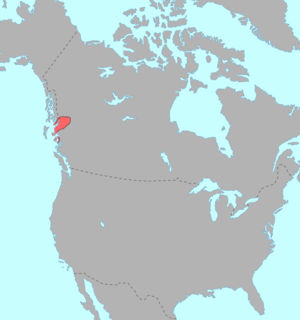Tsimshianic languages
| Tsimshianic | |
|---|---|
| Tsmksian | |
| Ethnicity | Tsimshian |
| Geographic distribution | British Columbia, Alaska |
| Linguistic classification |
Penutian ?
|
| Subdivisions |
|
| Glottolog | tsim1258[1] |
 Pre-contact distribution of Tsimshianic languages | |
The Tsimshianic languages are a family of languages spoken in northwestern British Columbia and in Southeast Alaska on Annette Island and Ketchikan. All Tsimshianic languages are endangered, some with only around 400 speakers. Only around 2,170 people of the ethnic Tsimshian /ˈsɪmʃiən/ population in Canada still speak a Tsimshian language;[2] about 50 of the 1,300 Tsimshian people living in Alaska still speak Coast Tsimshian.[3][4] Tsimshianic languages are considered by most linguists to be an independent language family, with four main languages: Coast Tsimshian, Southern Tsimshian, Nisg̱a’a, and Gitksan.[5]
The Tsimshianic languages were included by Edward Sapir in his Penutian hypothesis, a theory which is currently not widely accepted but is undergoing investigation by Marie-Lucie Tarpent.
Family division
Tsimshianic consists of 4 lects:
- Tsimshian (also known as Maritime Tsimshianic, Lower Tsimshian, Northern Tsimshian)
- Coast Tsimshian (also known as Tsimshian proper, Sm’algyax̣, Sm’algax)
- Southern Tsimshian (also known as Sgüüx̣s, Ski:xs, Old Klemtu) †
- Nass–Gitksan (also known as Interior Tsimshianic, Inland Tsimshianic)
Coast Tsimshian is spoken along the lower Skeena River in Northwestern British Columbia, on some neighbouring islands, and to the north at New Metlakatla, Alaska. Southern Tsimshian was spoken on an island quite far south of the Skeena River in the village of Klemtu, however it became extinct in 2013. Nisga’a is spoken along the Nass River. Gitksan is spoken along the Upper Skeena River around Hazelton and other areas.
Nisga’a and Gitksan are very closely related and are usually considered dialects of the same language by linguists. However, speakers from both groups consider themselves ethnically separate from each other and from the Tsimshian and thus consider Nisga’a and Gitksan to be separate languages. Coast and Southern Tsimshian are also often regarded as dialects of the same language.
As of 2013, Tsimshian courses are available at the University of Alaska Southeast.[6]
Phonology
Consonantal inventory of Proto-Tsimshian:[7]
| Labial | Dental | Palatal | Velar | Labio- velar |
Uvular | Labio- uvular |
Glottal | |||
|---|---|---|---|---|---|---|---|---|---|---|
| Non-continuous obstruent |
simple | *p | *t | *ts | *k | *kʷ | *q | *qʷ | *ʔ, *ʔʷ | |
| glottalized | *pʼ | *tʼ | *tsʼ | *kʼ | *kʷʼ | *qʼ | *qʷʼ | |||
| Fricative | *s, *ɬ | *x | *χ | *χʷ | *h, *hʷ | |||||
| Approximant | simple | *l | *j | *w | ||||||
| glottalized | *lˀ | *jˀ | *wˀ | |||||||
| Nasal | simple | *m | *n | |||||||
| glottalized | *mˀ | *nˀ | ||||||||
See also
Footnotes
- ↑ Hammarström, Harald; Forkel, Robert; Haspelmath, Martin, eds. (2017). "Tsimshian". Glottolog 3.0. Jena, Germany: Max Planck Institute for the Science of Human History.
- ↑ Statistics Canada 2006
- ↑ Alaska Native Language Center. (2001-12-07). "Tsimshian." Archived 2007-05-01 at the Wayback Machine. University of Alaska Fairbanks. Retrieved on 2007-04-11.
- ↑ Gordon, Raymond G., Jr. (ed.). (2005). "Tsimshian." Ethnologue: Languages of the World, 15th ed. (online version). Dallas, TX: SIL International Retrieved on 2007-04-11.
- ↑ Alaska Native Heritage Center. (2000). "Eyak, Haida, Tlingit & Tsimshian." Retrieved on 2007-04-11.
- ↑ Lisa Phu (Director) (2013-10-22). "UAS and Yukon College partnership advances Native language efforts". KTOO, Juneau, Alaska. 3:44 minutes in. Retrieved 2013-10-24. Missing or empty
|series=(help) - ↑ Tarpent, 1997, p. 70
Bibliography
- Boas, Franz. (1902). Tsimshian Texts. Washington: Bureau of American Ethnology. Bulletin 27.
- Boas, Franz. (1911). "Tsimshian." Handbook of American Indian Languages Bulletin No. 40, part I, pp. 287–422.
- Mithun, Marianne. (1999). The Languages of Native North America. Cambridge: Cambridge University Press. ISBN 0-521-23228-7 (hbk).
- Tarpent, Marie-Lucie. (1997). "Tsimshianic and Penutian: Problems, Methods, Results, and Implications." International Journal of American Linguistics 63.52-244.
External links
- Tsimshianic languages (YDLI)
- map of Northwest Coast First Nations (including Tsimshian and Nisga’a)
- Sm'algyax – "The Real Language"
- Dum Baal-dum
- Sealaska Heritage Institute
- A Zimshian Version of Portions of the Book of Common Prayer (1882) translated by William Ridley
- Bibliography of Materials on the Coast Tsimshian Language (YDLI)
- Bibliography of Materials on the South Tsimshian Language (YDLI)
- Bibliography of Materials on the Gitksan Language (YDLI)
- Bibliography of Materials on the Nisga'a Language (YDLI)